Eumorpha eacus
|
|
Updated as per
AN ANNOTATED CHECKLIST OF THE SPHINGIDAE OF BOLIVIA, October 2007
Updated as per Fauna Entomologica De Nicarauga, November 2007
Updated as per The Known Sphingidae of Costa Rica, November 2007
Updated as per CATE (Mexico, Nicaragua, French Guiana, Venezuela, Ecuador, Brazil); February 5, 2011
Updated as per personal communication with Larry Valentine (Itanhandu, Minas Gerais, Brazil, February 7, 2011); February 8, 2011
Updated as per personal communication with Gregory Nielsen (Villavicencio, Meta, Colombia, August 24, 2011, 500m); September 14, 2011
Updated as per personal communication with Johan van't Bosch (Albina, Marowijne, Suriname, July 20, 2011); November 20, 2011
Updated as per personal communication with Ezequiel Bustos (Shilap revta. lepid. 43 (172) diciembre, 2015, 615-631 eISSN 2340-4078 ISSN 0300-5267), January 4, 2016
|
Eumorpha megaeacus
(Hubner [1819]) Daphnis
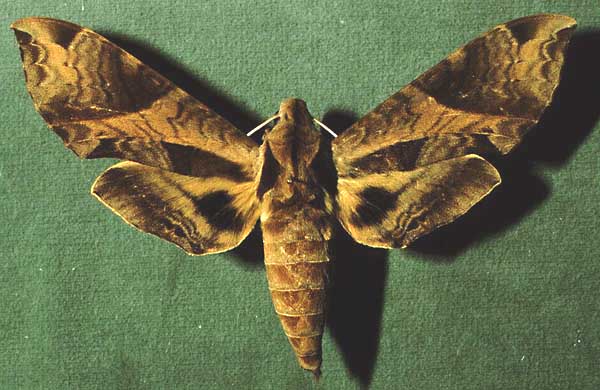
Eumorpha megaeacus male courtesy of Dan Janzen.
This site has been created by
Bill Oehlke at oehlkew@islandtelecom.com
Comments, suggestions and/or additional information are welcomed by Bill.
| TAXONOMY:
Superfamily: Sphingoidea, Dyar, 1902
Family: Sphingidae, Latreille, 1802
Subfamily: Macroglossinae, Harris, 1839
Tribe: Philampelini, Burmeister
Genus: Eumorpha, Hubner, [1807]
Species: megaeacus, (Hubner [1819]) |
MIDI MUSIC
"What.A.Wonderful.World"
copyright C. Odenkirk
MIDI CITY
ON.OFF
<bgsound src="world.mid" LOOP=FOREVER>
|
DISTRIBUTON:
Eumorpha megaeacus, the Eacus Sphinx
(wing span: 4 1/8 - 4 3/4 inches (10.5 - 12.1 cm), forewing length: (52mm)), flies in
Suriname
and probably throughout most of Central and South America to
Colombia: Meta: Villavicencio (500m) (GN);
Venezuela;
French Guiana: St. Laurent du Maroni;
Ecuador: Morona-Santiago;
southern Brazil: Minas Gerais: Itanhandu;
and west to
Bolivia: Beni: Yacuma (300-800m), and Argentina: Misiones.
Occasionally a stray is taken
in Texas.
Mexico;
Nicaragua: Rio San Juan, San Ramon;
Costa Rica: Guanacaste, Alajuela, Limon,
Heredia, Cartago.
I suspect it also flies in Guatemala, Honduras, Panama, Guyana and Peru,
but I have no confirmed reports as yet.
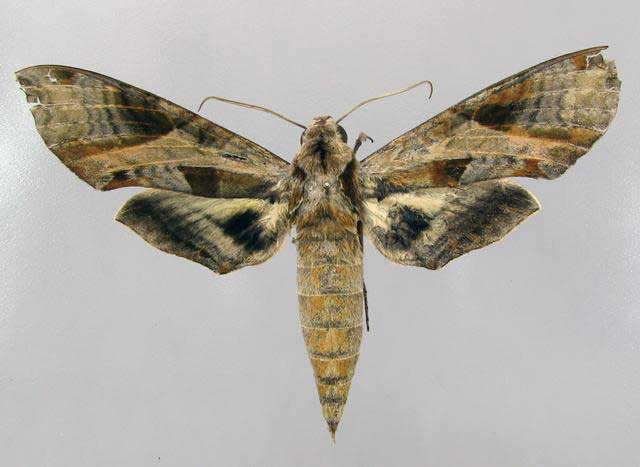
Eumorpha megaeacus, Villavicencio, Meta, Colombia,
Km 13 via Acacias; 04°03’55.0 N, 073°41’87.0 W
LFW 52mm, August 24, 2011, 500m, courtesy of Gregory Nielsen.
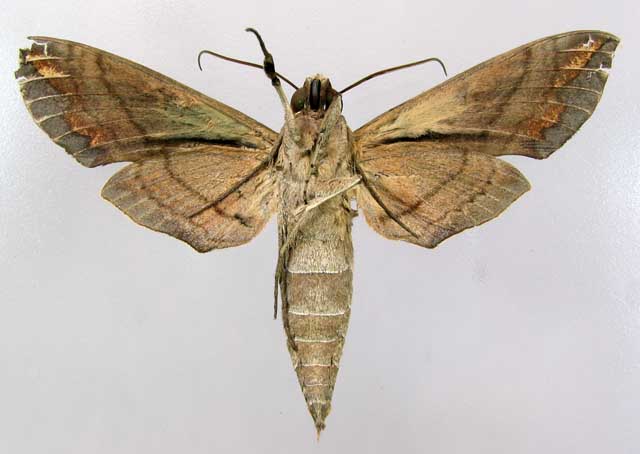
Eumorpha megaeacus (verso), Villavicencio, Meta, Colombia,
Km 13 via Acacias; 04°03’55.0 N, 073°41’87.0 W
August 24, 2011, 500m, courtesy of Gregory Nielsen.
Until very recently this moth was previously most
often incorrectly refered to as Eumorpha eacus.
The forewing upperside differs from other species of Eumorpha by the presence of a
conspicuous, but ill-defined, pinkish-beige longitudinal band running mostly between CuA1 and CuA2 from the wing base,
subparallel (slightly upwardly convex in the middle along its lower edge) to the inner margin, to near the outer margin.
Below the lower edge of this band, to the inner margin, appears a patchwork of patterns beginning with a tuft of bluish-green hairs at the wing base,
followed outwardly in order by a small black region,
a small brown patch, a grey patch with thin, weak, darker grey lines, a dark grey-brown trapezoid (wider at the top),
another grey area with weak darker grey lines, another dark trapezoid (wider at the bottom), with only its lower outer apex reaching the outer margin, and a
small solid grey area.
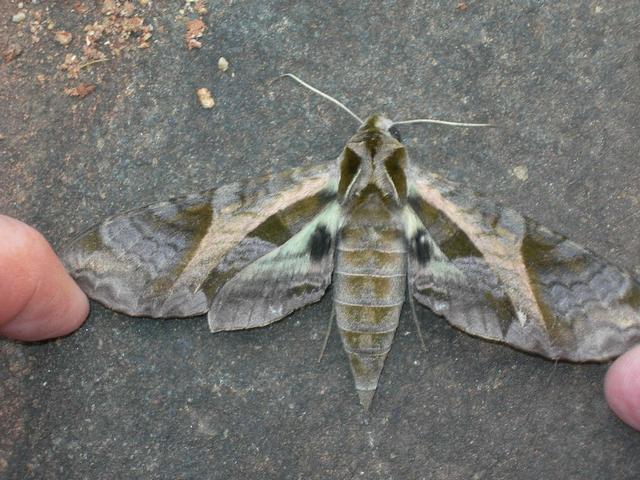
Eumorpha megaeacus, Itanhandu, Minas Gerais, Brazil,
February 7, 2011, courtesy of Larry Valentine.
FLIGHT TIMES AND PREFERRED FOOD PLANTS:
Eumorpha megaeacus adults are on the wing from February-March,
May-July and again from September-October in Costa Rica. Johan van't Bosch reports a July flight in Albina, Marowijne, Suriname.
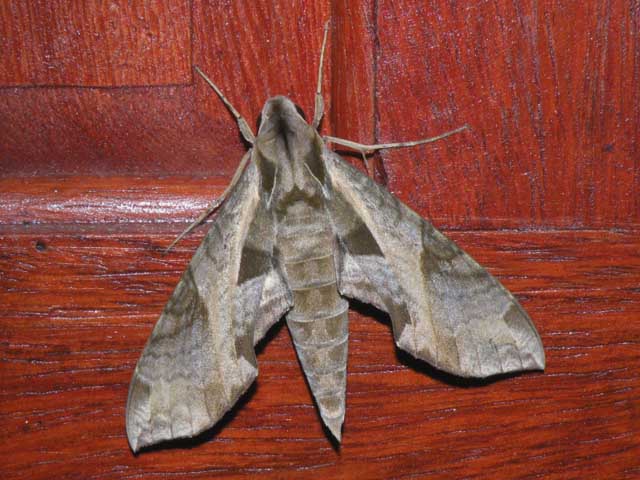
Eumorpha megaeacus, Albina, Marowijne District, Suriname
July 20, 2011, courtesy of Johan van't Bosch.
Eumorpha megaeacus larvae feed at night upon Jussiaea species
and upon members of the primrose family (Onagraceae).

Eumorpha megaeacus, Itanhandu, Minas Gerais, Brazil,
February 7, 2011, courtesy of Larry Valentine.
ECLOSION, SCENTING AND MATING:
Pupae wiggle to surface just prior to eclosion. Females call at night, and males fly into the wind to pick up and track
the pheromone plume.

Eumorpha megaeacus (verso), Itanhandu, Minas Gerais, Brazil,
February 7, 2011, courtesy of Larry Valentine.

Eumorpha megaeacus, Itanhandu, Minas Gerais, Brazil,
February 7, 2011, courtesy of Larry Valentine.
EGGS, LARVAE AND PUPAE:
Larvae feed on
Jussiaea species in the evening primrose family (Onagraceae).
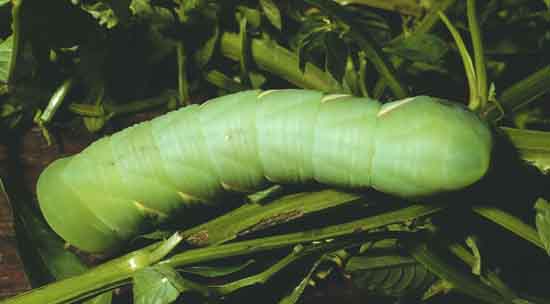
Eumorpha megaeacus, dorsal view, courtesy of Dan Janzen.
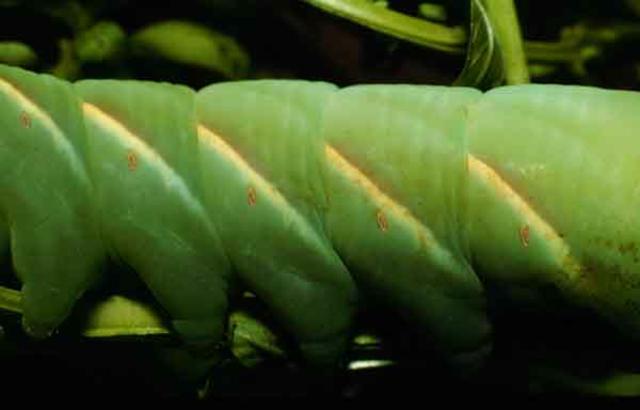
Eumorpha megaeacus fifth instar, Costa Rica, courtesy of Dan Janzen.
Larval Food Plants
Listed below are primary food plant(s) and alternate food plants. It is hoped that this
alphabetical listing followed by the common name of the foodplant will
prove useful. The list is not exhaustive. Experimenting with closely
related foodplants is worthwhile.
Return to Philampelini Index
Return to Sphingidae Index









